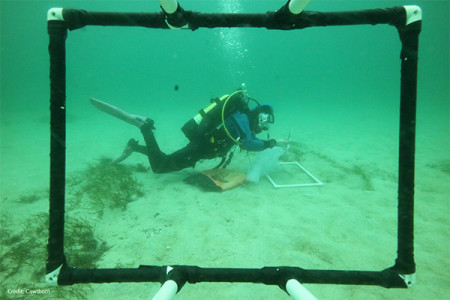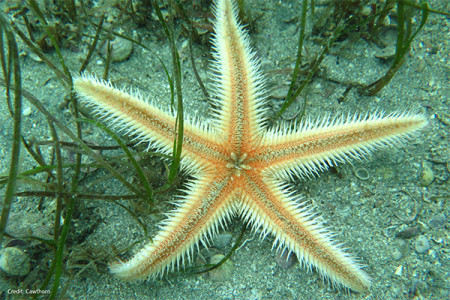Image credit: All underwater images courtesy of Cawthron Institute
"Seagrass is a really important habitat in our estuaries and shallow coastal environments. Our new monitoring programmes will, over time, help us keep track of how seagrass is faring, and hopefully disentangle the effects of the different pressures they are facing."
– Dr Michael Townsend, Coastal and Marine Science Team Leader

Diver getting a closer look during a subtidal seagrass survey
Have you ever heard of seagrass?
Seagrass, or karepō, is the only marine plant that flowers underwater.
Despite the name, and its long, green blades, it’s not grass at all. Rather, seagrasses are more closely related to the elegant (and land-based) arum lily. It’s known as a marine angiosperm.

Seagrass meadows are recognised internationally for their high ecological value.
There are many species of seagrass globally but only one species is found here in New Zealand, Zostera muelleri (rimurēhia).
Why should you care about seagrass?
Seagrass meadows are recognised internationally for their high ecological value. They provide habitat for juvenile marine species and promote higher biodiversity through their 3D structure compared to bare sediment. What does this mean?
Well, imagine you’re a tiny young fish. The openness of a flat seabed might leave you feeling a bit overexposed. Seagrass meadows would be the lovely, leafy bits of forest that you could shelter in until you’re big enough to hack it in the vast expanse of the bare seabed.

Seagrass monitoring at low tide
Seagrass meadows act as sinks for nutrients, help stabilize sediment, improve water clarity and sequester carbon dioxide, known as Blue Carbon.
Seagrass beds support healthy estuaries, and these estuaries then support activities including harvest of kai and areas of recreation. Seagrass beds continue to decline globally. Declines can be associated with poor water quality, increased suspended sediment and nutrient concentrations. These stressors reduce the amount of light able to reach the seagrass and provide optimal conditions for algae such as sea lettuce (Ulva spp.) which can smother and kill seagrass.
Where is seagrass found in New Zealand?
Historically, seagrass was common in the intertidal areas and subtidal channels of sheltered estuaries around the country. Intertidal just means the parts that are covered then exposed depending on the tide being in or out, while subtidal means areas that are always covered by water.
These days, it is predominately found in the intertidal and shallow subtidal areas, with only a few true subtidal beds restricted to offshore islands in the Waikato Region.
In 2019, Waikato Regional Council carried out subtidal seagrass surveys at Slipper and Great Mercury Islands. Results show that 83% of the seagrass bed extent in Huruhi Harbour, Ahuahu Great Mercury Islands has been lost since 1975. However, the seagrass beds around Slipper Island were 2-6 times larger than previously thought. These surveys have been repeated in March this year and we’re eagerly anticipating the results.
At Waikato Regional Council we monitor the water quality in three harbours with intertidal seagrass: Tairua, Kāwhia and Whāingaroa (Raglan) Harbours. Supported by funding from the most recent Long Term Plan, in the next year we will begin routine monitoring of seagrass across the region, looking at changes in the heath and condition and mapping the extent of the seagrass.
Coastal and Marine Science Team Leader Dr Michael Townsend says “Seagrass is a really important habitat in our estuaries and shallow coastal environments. It’s important that we take good care of the remaining subtidal beds through appropriate management actions and look at options to help them recover and flourish.”
“Our new monitoring programmes will, over time, help us keep track of how seagrass is faring, and hopefully disentangle the effects of the different pressures they are facing. We know that in some estuaries, seagrass is doing well, but in others it has declined in the last 10 years.
Understanding the effects of climate stress, like heatwave events, combined with varying water quality is a high priority,” he says.
What can you do to help seagrass flourish?
To help improve the health of estuaries, seagrass, and many other estuarine species, you can plant riparian zones around waterways and banks to stabilise the soil. This helps to limit and capture sediment entering our waterways that flow into estuaries and harbours.
Plus, when you’re out and about in estuaries and harbours, keep an eye out for seagrass. Make sure you avoid activities on top of seagrass beds like driving vehicles, walking, and mooring boats.
